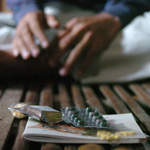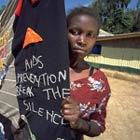



Context - In just 25 years, HIV has spread relentlessly from a few widely scattered “hot spots” to virtually every country in the world, infecting 65 million people and killing 25 million.
What has been done since 2001 and what can be done in the future to halt the spread of AIDS?
Note: Figures have been updated in 2008.
This Digest is a faithful summary of the leading scientific consensus report produced in 2006 by the Joint United Nations Programme on HIV/AIDS (UNAIDS): "![]()
In 2001, leaders of 189 nations recognized that AIDS was one of the most urgent issues of national and international development, and they agreed to a set of global targets to halt and begin to reverse the epidemic by 2015.
These targets focus on funding, prevention, and access to treatment for the general population and specific population groups. More...
2.1 At the end of 2005, about 38.6 (32*) million people were living with HIV worldwide. That year, 4.1 (2.9*) million became newly infected and 2.8 (2.2*) million died because of AIDS, so the overall number of people living with HIV has continued to rise. Today, about one adult in a hundred is living with HIV, but the extent of the epidemic varies greatly across countries and regions. More...
Note: The 2008 Report on Global AIDS epidemic by UNAIDS/WHO provides better
estimates of the number of people living with AIDS. Better data collecting
and estimation methods led to revised figures : the total estimated number
of people living with AIDS at the end of 2007 is 33.2 millions, with 2.5
million new infections and 2.1 million deaths (see the 2008 UNAIDS report![]()
2.2 The following world regions are heavily affected by the HIV epidemic.
Sub-Saharan Africa, where nearly one adult in 16 is living with HIV, is by far the most affected region, though the situation varies from country to country. In most Southern African countries, the share of people living with HIV has reached exceptionally high levels (up to one adult in three), though it seems to be levelling off everywhere except in South Africa. (2007 UNAIDS update: the epidemic in the South African area now seems to have leveled off, but the region is still the most severly affected.)
The Caribbean is the second-most affected region in the world. Nearly one adult in 62 is living with HIV, and AIDS is the leading cause of death among adults.
In certain countries of these two regions, however, changes in behaviour have reduced the share of people living with HIV. More...
2.3 In each of the following world regions, on average, less than one adult in 100 is living with HIV.
In Eastern Europe and central Asia, HIV/AIDS is still spreading, especially in Ukraine and the Russian Federation, and the number of people living with HIV has increased twenty-fold in less than a decade.
In Latin America, most infected people are living in large countries such as Brazil. However, smaller countries such as Belize and Honduras have a larger share of people living with AIDS among their adult population.
Overall, in North America, Western and Central Europe, AIDS deaths in 2005 were comparatively few as a consequence of widespread access to antiretroviral therapy. In the United States of America and in some countries of Europe, the epidemic seems to be increasing again among men who have sex with men.
In Asia, the share of HIV-infected people is decreasing in Cambodia, Thailand, and in parts of India, but is increasing in countries such as China, Indonesia, Viet Nam, and Papua New Guinea.
Across Oceania, HIV infection levels are low but persistent.
In the Middle East and North Africa, the proportion of adults infected with HIV is very low, except in Sudan, but seems to be growing in several countries, including Algeria, Iran, Libya and Morocco. More...

Overall, governments are now combating AIDS much more actively. Indeed, there is more coordination between countries and most now have a national plan to deal with AIDS, though systems to implement these plans are still inconsistent. More...
3.1 In some countries, there is now much better access to HIV prevention services, such as HIV counseling and testing, prevention education for young people, provision of condoms to those who are sexually active, treatment of other sexually transmitted diseases and programmes to reduce HIV-related stigma and discrimination. Still, such services only reach a small minority of those in need, and not enough young people and other vulnerable population groups. Programmes aimed at changing risky sexual behaviour have shown some success but progress is still needed in several areas. More...
3.2 A combination of antiretroviral treatments is effective in preventing or delaying AIDS-related illness and death. However, such lifelong therapies are complex and expensive to deliver. In recent years there has been a worldwide revolution in improving access to treatment, including in low-and middle-income countries. As a result of increased commitment, five times more people had access to antiretroviral therapy in 2005 than in 2001. Nonetheless, access to treatment is still insufficient as antiretroviral drugs only reach one in five of those who need them worldwide. The expansion of treatment access is hindered by the treatment costs and distance to treatment centres.
To improve access to treatment, countries need to train more medical staff, avoid drug shortages, combine HIV care with care for other health problems, reduce HIV stigma and discrimination and make sure that more people use HIV counselling and testing services. More...

4.1 Although many countries now have laws and regulations to promote human rights and to protect people living with HIV from discrimination; efforts to fight AIDS are still insufficiently based on human rights. In many cases the laws are not fully enforced, often because there is no money set aside for it. Moreover, some countries have laws that make it more difficult for certain vulnerable populations, such as sex workers, men who have sex with men, injecting drug users, prisoners, and refugees to get access to prevention services and treatment. More...
4.2 In recent years, more money has been available for HIV prevention. However, many countries focus prevention programmes on the general public rather than on vulnerable population groups, which would be more cost-effective and more likely to have an impact on the epidemic. Further attention should be given to preventing children from dropping out of school and to offering prevention services to injecting drug users, sex workers, men who have sex with men, and people affected by wars and disasters. More...
5.1 Though the money available to fight AIDS has increased significantly since 2001, it is still insufficient. Furthermore, it is expected that in the years ahead, the needs will increase more rapidly than the money raised. To plan the long-term fight against AIDS, funding needs to be managed in a better way so that countries can plan ahead knowing how much money they will receive each year, and systems must be in place to check that the promised money is actually given. More...
5.2 In recent years, research for preventive vaccines and microbicides has increased. Within a few years funding nearly doubled for research into the development of preventive vaccines and more than doubled for research into the development of microbicides that kill microbes in the vagina and prevent virus transmission by sexual route. Human trials are under way on the effectiveness of microbicides and other methods in preventing HIV, and ethical questions need to be taken into account in the conduct of such trials. More...

AIDS is exceptional and the response to AIDS must be equally exceptional. The considerable efforts made since 2001 are insufficient and uneven, and national long term plans are needed.
UNAIDS makes a series of recommendations for slowing and halting the spread of AIDS. More...
6.1 Commitment and leadership must be sustained and increased. Governments and heads of state need to be active and outspoken about their commitment to implement strategies that involve multiple sectors, including civil society and the private sector. More...
6.2 Financing must be sustained and increased and the money should be used as efficiently as possible to reach the people in need. International financing mechanisms should ensure that money for AIDS will be available in the future for an even stronger response to the epidemic. More...
6.3 AIDS-related stigma and discrimination must be aggressively addressed. Governments and all sectors of society should support measures to empower and protect women, to remove discrimination against vulnerable population groups, and to help all children stay in school. More...

To get as close as possible to the goal of offering treatment to all those who need it by 2010, a series of key areas require commitment and action. More...
7.1 HIV prevention should be strengthened and continuously emphasized to prevent millions of new infections each year. Access to clear, factual HIV prevention information and to HIV testing should be a right. HIV prevention services and education should particularly target young people, HIV-infected pregnant women and vulnerable groups, including sex workers, injecting drug users, men who have sex with men, and prisoners. More...
7.2 Access to HIV treatment needs to continue growing rapidly. This involves broadening access to HIV testing, building more treatment sites, increasing access to drugs that prevent HIV-related infections, reducing HIV stigma and discrimination, recruiting more medical staff, and keeping a constant and reliable supply of drugs. More...
7.3 Human resources and systems should be strengthened because the shortage of skilled workers in many developing countries is a major obstacle in the fight against AIDS. Therefore, efforts must be made to recruit and train health-care workers, encourage them to stay and work in their own countries, support the provision of HIV-related services by locals where needed, and integrate AIDS services into other primary health care programmes. More...
7.4 Prevention and treatment products such as condoms and antiretroviral drugs should be made more available and affordable, for instance by removing taxes, laws, or regulations that might hinder access to these products, allowing medicines into the market as soon as they are approved by the WHO, ensuring that children in need receive suitable drugs, and addressing the issues of pharmaceutical patents. More...
7.5 Substantially more money should be invested in research and development, especially by the private sector, in order to develop a preventive vaccine, microbicides, and new drugs, including those created specifically for children with HIV. In addition, greater cooperation between governments, civil society, and the private sector is needed. More...
7.6 Efforts should be made to counter the social impact of AIDS focusing first on people who are infected and their families and on children who have lost one or both parents to AIDS. They should be given treatment, access to therapy, and other forms of assistance. More...
In 2001, leaders of 189 nations recognized that AIDS is among the greatest development crises in human history and they agreed to a set of targets to halt and begin to reverse the epidemic by 2015.
Since 2001 important progress has been made in the fight against AIDS. Political commitment, coordination among partners, and money available for HIV/AIDS prevention and care have all increased significantly; access to treatment, testing and counselling has greatly improved globally; and blood for use in transfusions is now routinely screened for HIV in most countries.
However, progress is very uneven across the world and many more efforts are still needed in the fight against HIV. For instance, most people at high risk of HIV infection have no access to prevention services, a large number of babies are born with HIV, and huge numbers of children orphaned or made vulnerable by the epidemic have no proper care and support. In addition, there are other barriers to the effective fight against AIDS; for instance, stigma, discrimination and denial about issues such as sexuality and drug use.
The objective of halting and beginning to reverse the epidemic by 2015 is achievable, but success will require unprecedented long-term efforts and strong leadership at every level of society. More...

This summary is free and ad-free, as is all of our content. You can help us remain free and independant as well as to develop new ways to communicate science by becoming a Patron!